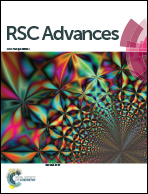Mechanistic and stereoselectivity study for the reaction of trifluoropyruvates with arylpropenes catalyzed by a cationic Lewis acid rhodium complex†
Abstract
The possible reaction mechanisms for a stereoselective carbonyl–ene reaction between trifluoropyruvates and arylpropenes catalyzed by a Lewis acid catalyst (Rh(III)-complex) have been investigated using density functional theory (DFT). Six possible reaction pathways, including four Lewis acid-catalyzed reaction pathways and two non-catalyzed reaction pathways have been studied in this work. The calculated results indicate that the Lewis acid catalyzed reaction pathways are more energetically favorable than the non-catalyzed reaction pathways. For the Lewis acid-catalyzed pathways, there are four steps including complexation of the catalyst with the trifluoropyruvates, C–C bond formation, proton transfer, and decomplexation processes. Our computational outcomes show that the C–C bond formation step is both the rate- and enantioselectivity-determining step, and the reaction pathway leading to the S-configured product is the most favorable pathway among the possible stereoselective pathways. Dication Rh(III)-complexes with different counterions (i.e., OTf−, Cl−, and BF4−) were considered as active catalysts, and the computed results indicate that the stereoselectivity can be improved with the presence of the counterion OTf−. All the calculated outcomes align well with the experimental observations. Moreover, the stereoselectivity associated with the chiral carbon center is attributed to lone pair delocalization and variations in the stronger interaction. Furthermore, analysis of the global reactivity index was also performed to explain the role of the Lewis acid catalyst.


 Please wait while we load your content...
Please wait while we load your content...